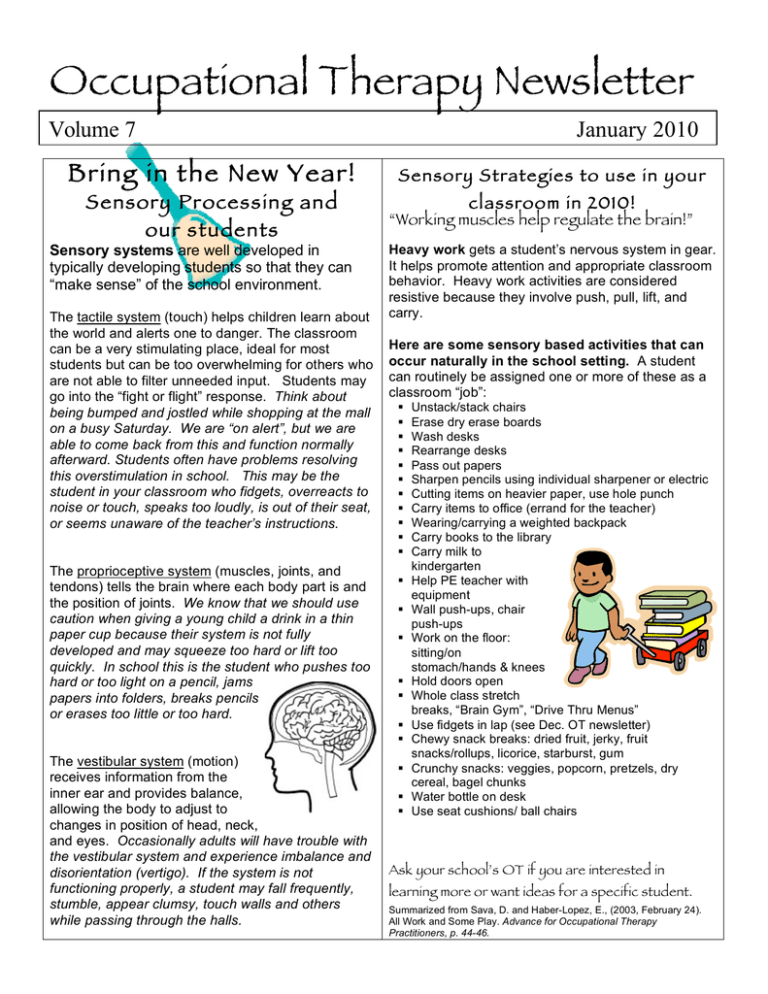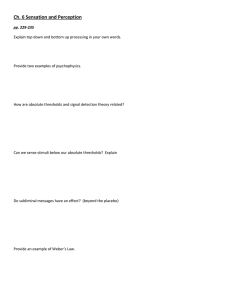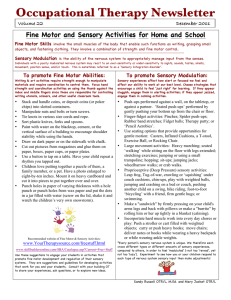Occupational Therapy Newsletter Bring in the New Year! Sensory Processing and our students
advertisement

Occupational Therapy Newsletter Volume 7 Bring in the New Year! Sensory Process in g an d our s tuden ts Sensory systems are well developed in typically developing students so that they can “make sense” of the school environment. The tactile system (touch) helps children learn about the world and alerts one to danger. The classroom can be a very stimulating place, ideal for most students but can be too overwhelming for others who are not able to filter unneeded input. Students may go into the “fight or flight” response. Think about being bumped and jostled while shopping at the mall on a busy Saturday. We are “on alert”, but we are able to come back from this and function normally afterward. Students often have problems resolving this overstimulation in school. This may be the student in your classroom who fidgets, overreacts to noise or touch, speaks too loudly, is out of their seat, or seems unaware of the teacher’s instructions. The proprioceptive system (muscles, joints, and tendons) tells the brain where each body part is and the position of joints. We know that we should use caution when giving a young child a drink in a thin paper cup because their system is not fully developed and may squeeze too hard or lift too quickly. In school this is the student who pushes too hard or too light on a pencil, jams papers into folders, breaks pencils or erases too little or too hard. The vestibular system (motion) receives information from the inner ear and provides balance, allowing the body to adjust to changes in position of head, neck, and eyes. Occasionally adults will have trouble with the vestibular system and experience imbalance and disorientation (vertigo). If the system is not functioning properly, a student may fall frequently, stumble, appear clumsy, touch walls and others while passing through the halls. January 2010 Sensory Strategies to use in your classroom in 2010! “Working muscles help regulate the brain!” Heavy work gets a student’s nervous system in gear. It helps promote attention and appropriate classroom behavior. Heavy work activities are considered resistive because they involve push, pull, lift, and carry. Here are some sensory based activities that can occur naturally in the school setting. A student can routinely be assigned one or more of these as a classroom “job”: Unstack/stack chairs Erase dry erase boards Wash desks Rearrange desks Pass out papers Sharpen pencils using individual sharpener or electric Cutting items on heavier paper, use hole punch Carry items to office (errand for the teacher) Wearing/carrying a weighted backpack Carry books to the library Carry milk to kindergarten Help PE teacher with equipment Wall push-ups, chair push-ups Work on the floor: sitting/on stomach/hands & knees Hold doors open Whole class stretch breaks, “Brain Gym”, “Drive Thru Menus” Use fidgets in lap (see Dec. OT newsletter) Chewy snack breaks: dried fruit, jerky, fruit snacks/rollups, licorice, starburst, gum Crunchy snacks: veggies, popcorn, pretzels, dry cereal, bagel chunks Water bottle on desk Use seat cushions/ ball chairs Ask your school’s OT if you are interested in learning more or want ideas for a specific student. Summarized from Sava, D. and Haber-Lopez, E., (2003, February 24). All Work and Some Play. Advance for Occupational Therapy Practitioners, p. 44-46.






